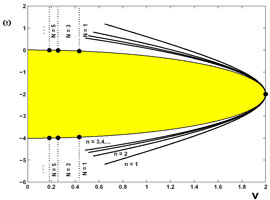| |
 A dynamical system is a description of the deterministic evolution of a state variable, whihc may be a finite
or an infinite dimensional object. Typically, a dynamical system is given as the flow of a vector field,
or the solution of a differential or a difference equation. Many examples of dynamical systems arise
in physical or engineering sciences and in biological or medical applications. Specific systems under
study by members of the AIMS Laboratory include waves in nonlinear optics, atmospheric vortices, and
surface and internal waves in the ocean, among many others. Modeling of physical systems by a dynamical
system can be either over finite dimensional phase space, the continuum, or on discrete lattices. Due to
the energy conservative nature of many of the problems of interest to AIMS Lab members, it is quite
common to work with Hamiltonian dynamical systems in particular.
A dynamical system is a description of the deterministic evolution of a state variable, whihc may be a finite
or an infinite dimensional object. Typically, a dynamical system is given as the flow of a vector field,
or the solution of a differential or a difference equation. Many examples of dynamical systems arise
in physical or engineering sciences and in biological or medical applications. Specific systems under
study by members of the AIMS Laboratory include waves in nonlinear optics, atmospheric vortices, and
surface and internal waves in the ocean, among many others. Modeling of physical systems by a dynamical
system can be either over finite dimensional phase space, the continuum, or on discrete lattices. Due to
the energy conservative nature of many of the problems of interest to AIMS Lab members, it is quite
common to work with Hamiltonian dynamical systems in particular.
Among the numerous analytical and numerical techniques available in the field of dynamical systems,
a classical point of view advocates an initial normal forms analysis. Under transformation, a mathematician
seeks to reduce a nonlinear dynamical system to its simplest form, eliminating inessential nonlinearities
or degrees of freedom. In the context of Hamiltonian systems this technique is in particular very
valuable in perturbation theory of invariant tori, in Nekhoroshev stability theory, in a Hamiltonian
version of multiple scales analysis for partial differential equations, and in the renormalization
process by which nonlinear wave turbulence can be understood.
Bifurcations occur in a dynamical system which depends upon a parameter when the behavior of the system
undergoes sudden changes at particular parameter values. The range of bifurcation problems includes
symmetry breaking and pattern formation in partial differential equations, resonance phenomena in
nonlinear oscillations, persistence and break-up of invariant tori, and transition to chaos involked
by nonlinear mode-interactions. These phenomena are investigated using diverse mathematical techniques,
including the analysis of normal forms of the governing differential equations, the Lyapunov-Schmidt
reduction to isolate the relevant degrees of freedom implicated in the phenomena under investigation,
singularity theory to resolve the possibly complex parameter dependent multiplicity of solutions,
group theoretic considerations as an organizing principle in the bifurcation and the normal forms
analysis, and perturbation techniques to classify and analyze the local behaviour of bifurcation
branches. Numerical computation combined with workstation computer graphics for visualizing
quantitative/global information are available to AIMS Lab researchers to provide further understanding
of the physical phenomena that lie as the ultimate goal of ones research.
|
|